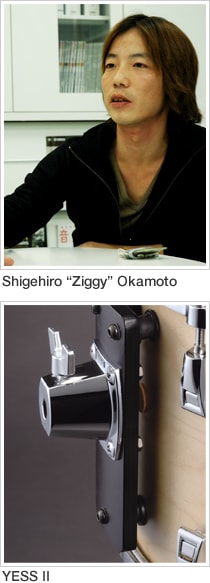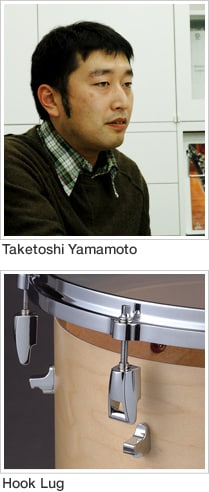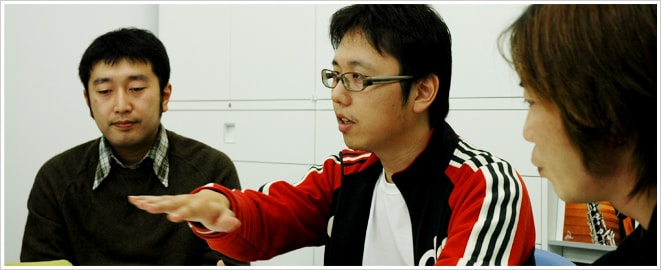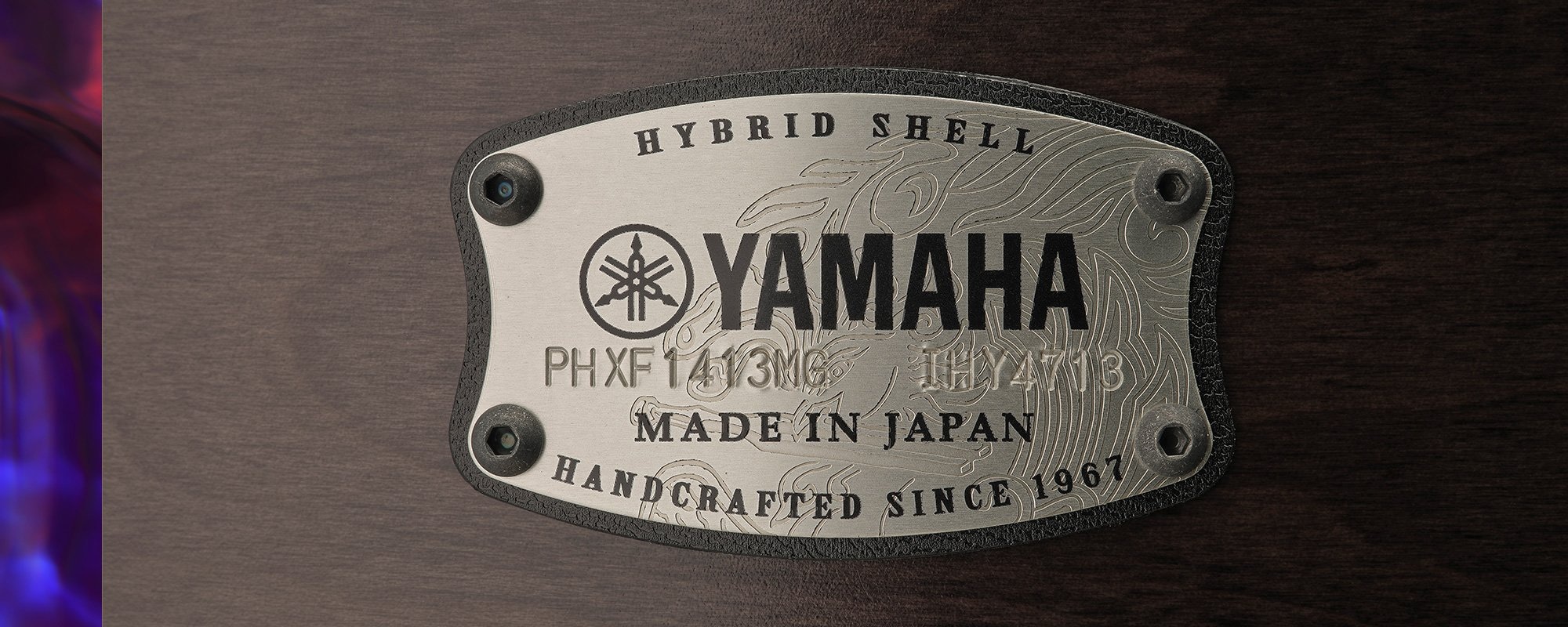PHX
Interview

The year 2007 marks Yamaha's 40th anniversary as a manufacturer of drums. Thus the new "PHX Series" is at last ready for launch, following and exhaustive development process. That process is embodied by the company's traditional logo design of a phoenix, which was registered in 1898 and arranged on the score stands of Yamaha's finest organs back then, symbolizing their technological innovation and superb musicality. With this series, which has been created through state-of-the art technology and all the precious know-how we have accumulated, we aim to establish another milestone for Yamaha drums.
The design team has striven to enhance the existing models by thoroughly reviewing them in every conceivable aspect. Of all the improvements made, the greatest change can be seen in the three areas of "hybrid shell structure," "YESSll" and "hook lugs." Accordingly, we interviewed the three designers, each of whom was responsible for specific area of the improvement effort, regarding the process of creating the PHX Series.
By laminating several shell materials, a richer, deeper sound can be produced.
The following is an interview with Mr. Banri Abe of Yamaha Drums & Percussion Design Section Product Development Department Wind, String & Percussion Instruments Division. Mr. Abe, designed the PHX shell.
——What did you have in mind as you began the PHX development?
Abe. we started with the goal of creating an instrument that could produce such a fat tone, wide dynamic range and big volume drummers would immediately feel that they had complete control of the sound they wanted relative to their playing style.
——Which particular areas did you review, Mr. Abe?
Abe. With great respect for the history of drums in solid all-maple, birch, beech or oak material, I set out to try thousands of combinations of various exotic and conventional woods to study the pure physics of harmonic complexity, sustain, tone-fundamentals and projection. Then, we finally reached to the best combination that we had looked for. As a result, now I can say with much confidence that we've created the best wooden shell.
——What is this combination, exactly?
Abe. Jatoba, an extremely dense wood material, was chosen as the core laminate. Kapur was “sandwiched” on either side of the core having slightly less density. Lastly, North American maple, with less density than Kapur, was “sandwiched” around the Jatoba-Kapur core. This graduating density from the core of the shell created a vibration that was far superior to any other laminate combination I tested.
——In this development you created two shell types: one finished with maple only, and the other finished with an ash exterior added over the maple. Is that right?
Abe. Yes, it is. The purpose of creating the ash version was purely to add a cosmetic dimension suitable for this elite model. This attempt actually brought out an unexpected but favorable effect. It turned out to have a different tone color and unique, individual character.
——Are there any other areas that have been improved by comparison to conventional shells?
Abe. The shell itself was so powerful however, to optimize it's power for making music we conducted thousands of experiments on bearing edge combinations, ventilation and diameter-depth dimensions with digital signal processors and of course listening. All the time we were recording the data to maximize the musicality. Conducting experiments by recording data each time allowed us to express, in numerical values, the changes to the sound caused by edge shapes. We also improved the vent-hole application which makes a significant effect on the sound and feel of a drum.
This led to some even more cool ideas.
We have always been putting the lugs and mount posts on the same nodal point plain to create maximum resonance however; by moving the lug points closer to the equator of the drum we created more musical decay and a noticeably lower fundamental. The computer-generated waveforms were self-evident.
Once we took this prototype to some of our most famous artists for evaluation, in a professional Los Angeles studio, they unanimously agreed that it was completely different, in a positive way, to the best drums we had crafted for them over the last 15 to 25 years. They were surprised at its well-balanced tone. They emphasized that no equalization would be necessary to record these drums. These artists statements confirmed that we had crafted the drums that could be the benchmark by which all others are judged.

“YESS II (Yamaha Enhanced Sustain System II)”: The tom mount system that optimizes the shell vibrations
Next, we interviewed Mr. Shigehiro "Ziggy" Okamoto, another member of the Yamaha Drums design team. Ziggy designed the “YESS II” tom mount system.
——How does a mount effect the sound or performance of a drum?
Ziggy. Small drums tend to loose a degree of resonance into the hardware on which it is mounted sometimes causing an undesirable decay. Contrary to this, the vibrations produced by a large drum are extended sometimes causing an undesirable sustain. As a result, vibrations may not be appropriately balanced. Mounting systems vary with all of our competitors choosing to add “floating” mounting systems which “hang” on lugs, tension-rods or hoops. All of these systems in our opinion either inhibit the sound or make changing drum heads extremely inconvenient and laborious. Y.E.S.S.(Yamaha ENHANCED SUSTAIN SYSTEM) was introduced in the early 90's with the mission of using “nodal point®” (the non vibrating part of the drum) suspension that provided all of benefit to drummers with its improved sound and conveniences. However, after some experiments we found there was something more we could do to improve it.
——More specifically, what improvements have you made?
Ziggy. I developed a rubber “floater” so that there is no actual direct vibration of the shell touching the mounting hardware that is, wood on metal. Secondly the rubber “floaters” are attached to a wooden plate which further reduces metallic overtone and emphasizes genuine shell sound. Lastly, we added another stabilizing “floater” on the nodal point of the resonant plain (For 16"tom, one more stabilizer is added to control too long sustain) which created a desirable decay and improved stability.

New Hook Lug -- Making the Most of the Head Vibrations
Hook Lugs, the components used to secure the head to the shell, greatly affect the tone color and "rumble" of the completed drums.
The new hook lug was designed by Mr. Taketoshi Yamamoto of the Drums & Percussion Design Section Product Development Department Wind, String & Percussion Instruments Division.
Yamamoto. The hook lugs used for the absolute series are of the detachable/attachable type, so head replacement is very easy. In this new development, I worked in great detail to improve the lug post and the shape of the lug case over that of the conventional hook lug. The new hook lugs allow the loss. This improves the sound, and at the same time it maintains the superiority if the conventional detachable/attachable mechanism.

The PHX Series : A Constant Evolution
——I understand that there are three major improvements, but haven't you worked to improve other aspects as well?
Ziggy. We looked at everything. We kept on some of current specifications as cast-aluminum hoops, steel floor tom legs and so on, because we reconfirmed that they were already well balanced, but still we continue to investigate new ideas. We must continue to make the best drums in the world.
Yamamoto. The verification results were all digitized during the revisions. I'm certain that this will help our future development tremendously. Of course, we are fortunate to have our creations evaluated by the best drummers in the world at every stage of development.
Ziggy. This project started three years ago. We thought it would take more time, because our goal was to create the ultra-drum however, after going through the process of trial and error with many prototypes, we were really on to something pretty close to the beginning of our research.
Abe. We were a bit nervous, but we gathered our courage and asked the artists to compare this new prototype to their own instruments at the meeting for the trial playing session. We also asked them to try attaching the heads they were currently using to the PHX drums. We learned a lot.
Ziggy. In every area, the PHX series was critically evaluated by all the participating artists, regardless of their musical genres. The quality of the recorded sound of PHX was also evaluated in state-of-the-art studios with the finest microphones. The conclusion being very positive, I can proudly state the live sound of PHX is of very high quality.
Abe. We also have evaluated everything out there against PHX. Arrogant as this may sound, PHX is the best by far and we'll only make it better.
Yamamoto. In fact, we're still conducting verifications with great attention to even the smallest details.
Ziggy. The PHX Series is supposed to stay ahead of all other products. We will apply the technology obtained in the course of PHX development to other models as well. This will mean an upgrade of the entire line of Yamaha drum products over time.

From left: Yamamoto, the developer of the new hook lug; Abe, the developer of the hybrid shell structure; and Okamoto, the developer of YESS II. The passion of these young men has made it possible to create the PHX Series.






